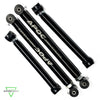The control arms connect your Truck or SUV wheels to the steering rack. Control arms are designed to keep your tires attached to the vehicle’s frame while retaining proper rotation and handling. The control arms support the vertical motion of axles when your vehicle encounters different levels on the road and keeps your axle center from front to back.
When vehicles are lifted, both tires begin to sink in toward the frame. Without a long enough lower control arm, your tires could contact the frame during hard wheeling or off-roading.
Your aftermarket control arm set will help extend axles during operation to ensure your wheels and navigation stay centered. The parts include:
- Front control arms smooth pinion angles for improved traction
- Rear control arms prevent the axle from moving back and forth
- Lower control arms position the axle and channel energy from the wheels to the chassis, preventing axle wrapping
What an aftermarket arms control system provides:
- Improves directional stability
- Maintains a straight, perpendicular direction while driving
- Durable materials with longer use life
- Improved torque and traction
- Improved hard wheeling performance
- Protects your vehicle's frame if a new lift is installed
What is Caster Angle?
Your Vehicle's caster angle is a susceptible setup that affects your vertical axis of steering. During a suspension alignment, the caster angle is calibrated, so your tire self-center improves straight-line navigation. A positive caster angle occurs when the slope of the angle is geared toward the top rear of your vehicle.
A positive caster angle occurs when the lower control arms are extended while the upper control arms are retracted. You’ll want your caster angle to extend from in front of where your tire will contact the road, so the tires straighten out once steering is released. Decreasing your caster angle will result in tighter steering but restricted wheel self-centering. A positive caster angle will improve stability at high speeds and improve cornering.
What is Axle Wrapping/Binding
“Axle wrap” is defined as a change in your pinion angle. Axle wrap occurs when your axle wraps itself around the springs. This common phenomenon in leaf-sprung vehicles can happen at heavy wheeling or towing. When an axle wrap releases, it causes a phenomenon known as a “wheel hop.”
You’ll be able to feel a wheel hop by the sudden jolt in your vehicle during operation. A wheel hop could cause significant damage to your u-joints, springs, and, most importantly, your drivetrain. If your car is lifted above 3”, it’s ideal to have adjustable control arms to keep your pinion angle in place, preventing axle wrap from occurring.
Weaknesses in a vehicle's Stock Control Arms
An aggressive lift kit could interfere with your vehicle's drivetrain angles, causing damage. Therefore, many experts recommend purchasing an aftermarket control arm set for lifts above 3” to prevent axle wrap from occurring and improve torque.
Even with an entry-level lift kit advertised at 2.5”, a stock vehicle’s estimated lift height could be closer to 4”. With a stock control arm system, your caster angle could decrease, and your alignment will slowly be tweaked. Aftermarket control arms are designed to keep these mechanics in place while improving traction controls and torque.
Here are the biggest cons of keeping your stock control arm system with an entry-level lift kit:
- OEM rubber bushings have a low use-life and reduced performance at high speeds
- It could reduce track bar performance resulting in side-to-side momentum during sharp turns
- Stock control arms could leave your axle at risk of binding or your vehicle at risk of wheel hops
- Raising your lift will result in decreased straight-line navigation performance
Choosing Aftermarket Control Arms for Your Vehicle
Aftermarket control arms are an excellent way to augment your lift system and ensure your vehicle runs smoothly. Choose from short, adjustable control arms for lifts below 5” and long arms for higher lift kits. You can find a control arm length that will fit any size lift, and the possibilities are endless.
Lifted vehicle owners can choose from either fixed or adjustable control arms. Most new vehicle feature fixed control arms that offer incredible strength and can be augmented with adjustable control arms for precise angling.
Some lift kit models utilize an adjustable control arm kit. Adjustable control arms allow you to center your axle with your wheel well and set your pinion angle.
Aftermarket control arms are designed with tube steel and typically contain urethane or polyurethane bushings. They are also designed to bolt directly onto your vehicle and only require a few simple tools.
Rubber vs. Polyurethane Bushings
Polyurethane bushings provide more reliability under harsh conditions than rubber end bushings. While polyurethane bushings still allow the suspension to bind under hard wheeling, its high-quality design provides better handling. Most of all, rubber bushings wear out very fast, which could have greater implications for your pinion-axle system than you realize.
The Pros and Cons of Wrangler Aftermarket Control Arms
Pros
- Prevents axle binding and wheel hops
- Manufactured using robust and lightweight material for longer use-life and greater reliability
- Improved torque, traction, and handling
Cons
- Longer control arms become more expensive
- Drivers could feel the vibration of the vehicle going over bumps.
Benefits of Adjustable vs. Non-Adjustable Suspension
Adjustable control arms are necessary for rigs with higher ground clearances. Adjustable control arms allow drivers to properly calibrate caster and pinion angles, which improves performance and centers the axle.
Non-adjustable control arms are available for higher suspension lifts, though they could prove counterintuitive without proper calibration or fit. A non-adjustable control arm also can’t eliminate pinion angle deflections when lifted, which could cause wear and tear to your suspension system and drivetrain.
Control Arm Installation Difficulty
Installing a new control arm is simple and requires a few tools. As a disclaimer, installing an adjustable control arm on an entry-level lift kit may require professional assistance, so you don’t accidentally compromise your springs.
With wheel chocks, a wrench, a tire jack, and basic tools, you can replace your control arms in an hour. Removing the control arms may be the most challenging part, but any layman with basic technical know-how could accomplish it. Remember to measure your caster angle after completion using a camber/caster angle gauge.













